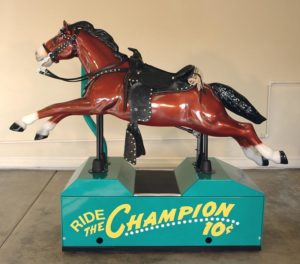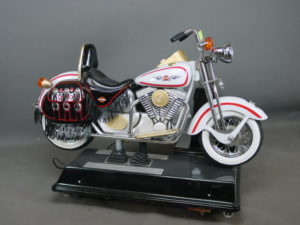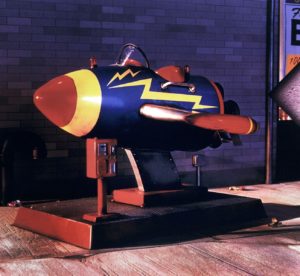
Mom dreaded summer vacation from school. That meant that I would likely be accompanying her to Farrier’s IGA in Miami, Oklahoma. That additionally meant that I would be relentlessly “warting” (her word for begging) for all sorts of food items that she could normally bypass when I was absent. It also meant that I would hammer her for a dime to drop into the horse kiddie ride.
The kiddie ride was strategically placed at the entrance of the store. Mr. Farrier knew that it would prove irresistible to kids accompanying their mothers, and that the kids would then do the selling.
Mothers probably wanted to wring Mr. Farrier’s neck.
But he wasn’t alone. Probably every 1960’s supermarket in the US had a kiddie ride or two located near the store entrance. Back in those days, a thin dime would buy a minute or so of sheer heaven for a Boomer kid, an investment that our mothers would frequently cough up to stop that relentless begging sound…
I couldn’t find much of a history for kiddie rides. No doubt, they have existed since at least the 19th century. Once upon a time, an enterprising businessman would let a child ride a tame donkey or pony for a reasonable fee (to be begged from the parents by the child), perhaps even throwing in a photograph of the child on said equine as part of the deal.
However, as urban life became more sophisticated, it became difficult to keep live animals at places of business. Thus, it would have been a natural transition from real ponies to mechanical models parked in potentially lucrative locations.
The result was that we Boomer children were surrounded by magical rides that would provide us with about a minute of musical, mechanized motion for a thin dime.

They could be found everywhere. Cafes, bus stations, hotel lobbies, just about any place where parents with children were likely to congregate with some time to kill.
And they weren’t all horses, of course. Horses were my favorite, but a kid could also encounter large plastic creations including elephants, Donald Duck (and a host of other cartoon characters), ferris wheels, the Batmobile (and many other types of vehicles), kangaroos, chipmunks, pigs, and fanciful creatures like Puff the Magic Dragon.
The car rides frequently had the advantage of being able to entertain two kids at once, although this would also frequently precipitate a power struggle between the kids as to who got to “drive.”

Most of the rides provided the same product for a dime: 60-90 seconds of back and forth motion, accompanied by music from sophisticated 1960’s era electronics. Sometimes, other sounds would also be generated, like motor noises, whooping Indians, or gunfire.
Some games would combine two joys for the price of one. For instance, there was an Indian Scout ride that provided a kid with a galloping horse PLUS a six-shooter to hit targets with at the same time! I don’t recall ever being lucky enough to spot one of those back in the day.
The amazing thing about the kiddie rides is their timelessness. Thus, many businesses are making good money restoring vintage models and selling them to collectors, arcades, and even many of the same types of establishments that hosted the games when we were kids.
Even the price has stayed kind. Most rides take a single quarter. The businesses are no longer making much or any money from the ride itself, but they are effective at attracting eager kids and nostalgic parents and grandparents, who presumably will purchase things that DO return a profit.
The horse ride cost a penny at Hunky Dinky Grocery Store in Iowa in the late 50s.
I can still remember climbing on the Champion kiddie ride at the front of the Crest grocery store in Belton, Missouri, when I was 4 or 5. Later, when I started riding actual horses, I was surprised how similar it was to the kiddie ride.